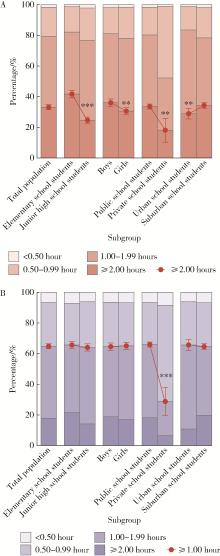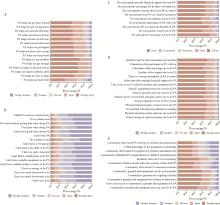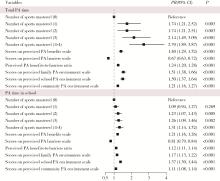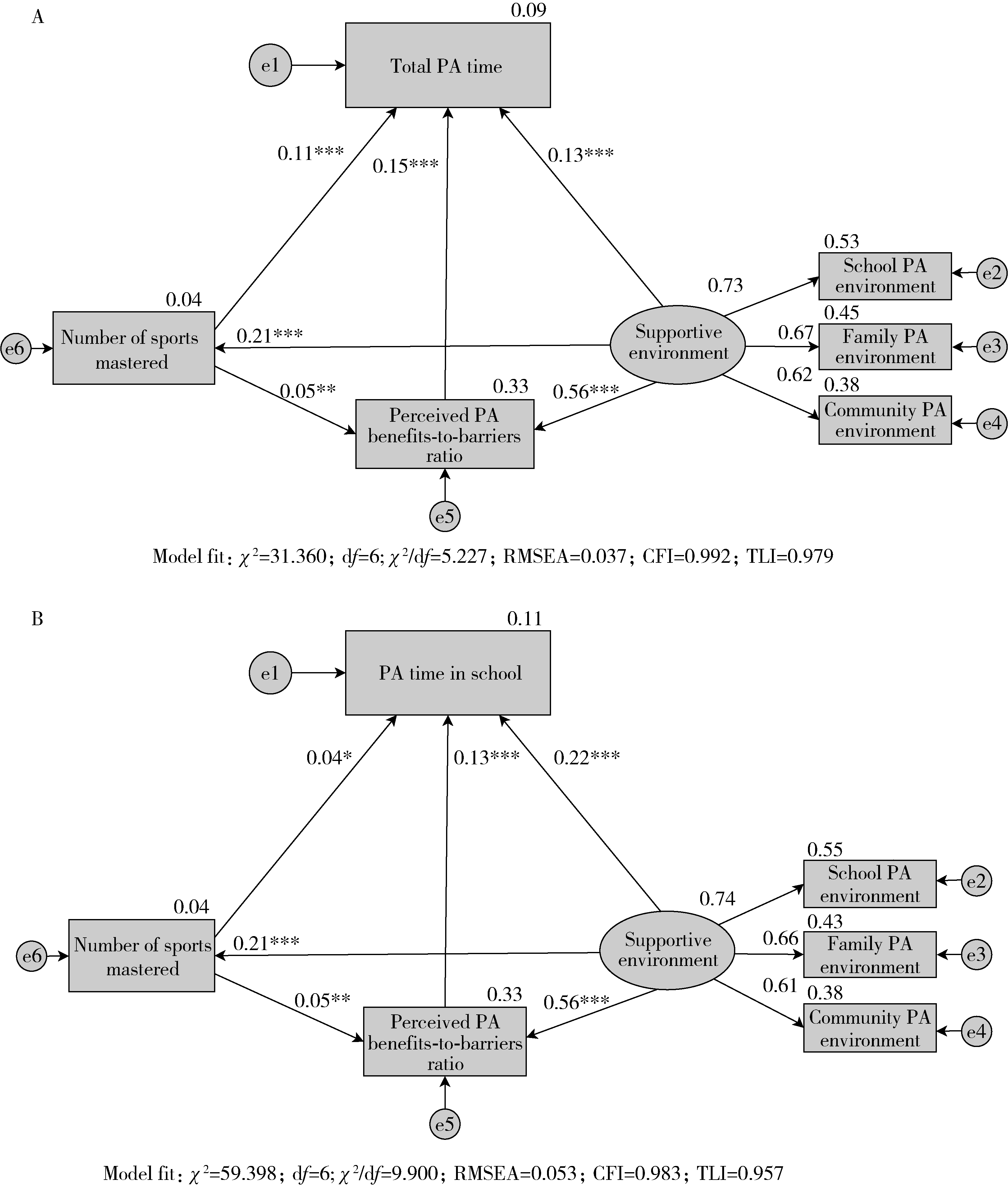北京大学学报(医学版) ›› 2024, Vol. 56 ›› Issue (3): 403-410. doi: 10.19723/j.issn.1671-167X.2024.03.005
北京市中小学生身体活动时间现状及影响因素的路径
蔡珊,张依航,陈子玥,刘云飞,党佳佳,师嫡,李佳欣,黄天彧,马军,宋逸*( )
)
- 北京大学公共卫生学院,北京大学儿童青少年卫生研究所,北京 100191
Status and pathways of factors influencing physical activity time among elementary and junior high school students in Beijing
Shan CAI,Yihang ZHANG,Ziyue CHEN,Yunfe LIU,Jiajia DANG,Di SHI,Jiaxin LI,Tianyu HUANG,Jun MA,Yi SONG*( )
)
- Institute of Child and Adolescent Health, Peking University School of Public Health, Beijing 100191, China
摘要:
目的: 描述北京市中小学生每天身体活动时间现况,并分析个体、家庭、学校、社区层面的影响因素及其路径。方法: 使用2023年北京市中小学生的横断面调查数据,研究对象为3 157名小学生和初中生。使用问卷调查学生的基本信息、每天总体和在校身体活动时间、掌握的运动项目数量,以及感知身体活动益处和障碍情况,感知家庭、学校和社区身体活动支持性环境情况。采用Log-binomial回归模型分析身体活动与影响因素的关联,使用结构方程模型进行影响因素的路径分析。结果: 2023年北京市中小学生每天总体身体活动≥2 h报告率为33.1%, 每天在校身体活动≥1 h报告率为64.8%。学生掌握的运动项目数量与每天总体身体活动≥2 h报告率呈剂量反应关系(P-trend<0.001),感知身体活动益处得分和障碍得分比值及感知家庭、学校、社区身体活动支持性环境得分均与学生每天总体身体活动≥2 h报告率呈正相关关系(PR=1.24,95%CI:1.20~1.28;PR=1.51,95%CI:1.38~1.66;PR=1.50,95%CI:1.37~1.64;PR=1.21,95%CI:1.16~1.27)。结构方程模型显示,学生掌握的运动项目数量(β=0.11,P<0.001)、感知身体活动益处得分和障碍得分比值(β=0.15,P<0.001),以及由家庭、学校和社区构成的支持性环境得分(β=0.13,P<0.001)均与学生每天总体身体活动≥2 h报告率直接相关,其中支持性环境得分通过影响学生掌握的运动项目数量(β=0.21,P<0.001)、感知身体活动益处得分和障碍得分比值(β=0.56,P<0.001),学生掌握的运动项目数量通过影响感知身体活动益处得分和障碍得分比值(β=0.05,P=0.003),与学生每天总体身体活动≥2 h报告率间接相关。学生每天在校身体活动≥1 h报告率与每天总体身体活动≥2 h报告率的影响因素及路径相似。结论: 北京市中小学生身体活动时间未达到国家要求,未来需构建家庭、学校和社区一体化身体活动支持性环境,培育中小学生的运动技能,树立自主运动的观念,保障中小学生每天校内外各1 h身体活动时间。
中图分类号:
- R179
| 1 |
Kohl HW 3rd , Craig CL , Lambert EV , et al. The pandemic of physical inactivity: Global action for public health[J]. Lancet, 2012, 380 (9838): 294- 305.
doi: 10.1016/S0140-6736(12)60898-8 |
| 2 | 张云婷, 马生霞, 陈畅, 等. 中国儿童青少年身体活动指南[J]. 中国循证儿科杂志, 2017, 12 (6): 401- 409. |
| 3 |
Chen P , Wang D , Shen H , et al. Physical activity and health in Chinese children and adolescents: Expert consensus statement (2020)[J]. Br J Sports Med, 2020, 54 (22): 1321- 1331.
doi: 10.1136/bjsports-2020-102261 |
| 4 | 中华人民共和国教育部. 教育部等五部门关于全面加强和改进新时代学校卫生与健康教育工作的意见[EB/OL]. (2021-08-10) [2024-01-16]. http://www.moe.gov.cn/srcsite/A17/moe_943/moe_946/202108/t20210824_553917.html. |
| 5 | World Health Organization. Physical activity [EB/OL]. (2022-10-05) [2023-12-06]. https://www.who.int/news-room/fact-sheets/detail/physical-activity. |
| 6 | 赵文华, 李可基, 王玉英, 等. 中国人群身体活动指南(2021)[J]. 中国公共卫生, 2022, 38 (2): 129- 130. |
| 7 |
Welk GJ . The youth physical activity promotion model: A conceptual bridge between theory and practice[J]. Quest, 1999, 51 (1): 5- 23.
doi: 10.1080/00336297.1999.10484297 |
| 8 | 蔡玉军, 李凯, 陈思同, 等. 青少年身体活动促进模型: 理论架构、实践应用与展望[J]. 武汉体育学院学报, 2019, 53 (3): 89- 94. |
| 9 |
Seabra AC , Maia J , Seabra AF , et al. Evaluating the youth physical activity promotion model among Portuguese elementary schoolchildren[J]. J Phys Act Health, 2013, 10 (8): 1159- 1165.
doi: 10.1123/jpah.10.8.1159 |
| 10 |
Ling J , Robbins LB , McCarthy VL , et al. Psychosocial determinants of physical activity in children attending afterschool programs: A path analysis[J]. Nurs Res, 2015, 64 (3): 190- 199.
doi: 10.1097/NNR.0000000000000084 |
| 11 | World Health Organization. Global action plan on physical activity 2018-2030: More active people for a healthier world [EB/OL]. (2018-06-01) [2024-01-16]. https://www.who.int/publications/i/item/9789241514187. |
| 12 | 中华人民共和国教育部. 教育部等十三部门关于健全学校家庭社会协同育人机制的意见[EB/OL]. (2023-01-17) [2024-01-17]. http://www.moe.gov.cn/srcsite/A06/s3325/202301/t20230119_1039746.html. |
| 13 | 马宁, 钟盼亮, 党佳佳, 等. 中国9~18岁汉族儿童青少年感知运动益处与障碍及其与校内体育活动时间的关系[J]. 中华流行病学杂志, 2023, 44 (3): 422- 429. |
| 14 |
Robbins LB , Wu TY , Sikorskii A , et al. Psychometric assessment of the adolescent physical activity perceived benefits and barriers scales[J]. J Nurs Meas, 2008, 16 (2): 98- 112.
doi: 10.1891/1061-3749.16.2.98 |
| 15 | 余伟峻. 家庭体育环境影响儿童身体活动的模型构建及干预研究[D]. 上海: 上海体育学院, 2023. |
| 16 | 洪婧婧. 体育环境与上海市初中生体育锻炼行为的关系研究[D]. 上海: 上海体育学院, 2023. |
| 17 | Antay-Bedregal D , Camargo-Revello E , Alvarado GF . Associated factors vs risk factors in cross-sectional studies[J]. Patient Prefer Adherence, 2015, 9, 1635- 1636. |
| 18 | Øvrebø B , Kjøllesdal M , Stea TH , et al. The influence of immigrant background and parental education on overweight and obesity in 8-year-old children in Norway[J]. BMC Public Health, 2023, 23 (1): 1660. |
| 19 | 李莉萍. 北京市民办中小学体育课程开展状况的调查分析——以北京清泉学校为例[J]. 当代体育科技, 2018, 8 (35): 56- 57. |
| 20 | 王逸姮. 北京市东城区中小学体育场地设施现状研究[D]. 北京: 首都体育学院, 2018. |
| 21 | 袁伟. 苏州市民办初中学校体育工作开展现状研究[D]. 山东聊城: 聊城大学, 2023. |
| 22 | Guthold R , Stevens GA , Riley LM , et al. Global trends in insufficient physical activity among adolescents: A pooled analysis of 298 population-based surveys with 1.6 million participants[J]. Lancet Child Adolesc Health, 2020, 4 (1): 23- 35. |
| 23 | Ricardo LIC , Wendt A , Costa CDS , et al. Gender inequalities in physical activity among adolescents from 64 Global South countries[J]. J Sport Health Sci, 2022, 11 (4): 509- 520. |
| 24 | The Lancet Public Health . Time to tackle the physical activity gender gap[J]. Lancet Public Health, 2019, 4 (8): e360. |
| 25 | 中华人民共和国中央人民政府. 教育部关于印发义务教育课程方案和课程标准(2022年版)的通知[EB/OL]. (2022-03-25) [2024-01-25]. https://www.gov.cn/zhengce/zhengceku/2022-04/21/content_5686535.htm. |
| 26 | 中华人民共和国中央人民政府. 教育部办公厅关于进一步加强中小学生体质健康管理工作的通知[EB/OL]. (2021-04-19) [2024-01-16]. https://www.gov.cn/zhengce/zhengceku/2021-04/26/content_5602164.htm. |
| 27 | 国家体育总局. 全社会联动, 努力提升青少年体质健康水平[EB/OL]. (2020-10-19) [2024-01-29]. https://www.sport.gov.cn/n20001280/n20745751/n20767279/c21256932/content.html. |
| 28 | 王磊, 丁源源, 王思乐. 我国儿童青少年体质健康家校社多元联动模式的研究[J]. 当代体育科技, 2023, 13 (29): 140- 144. |
| 29 | 杨燕国, 汪晓赞, 孔琳. 我国儿童青少年体育健康促进多元联动的实践路径及推进策略[J]. 上海体育学院学报, 2023, 47 (3): 81- 89. |
| 30 | Brustad RJ . Attraction to physical activity in urban schoolchildren: Parental socialization and gender influences[J]. Res Q Exerc Sport, 1996, 67 (3): 316- 323. |
| 31 | Paxton RJ , Estabrooks PA , Dzewaltowski D . Attraction to physical activity mediates the relationship between perceived competence and physical activity in youth[J]. Res Q Exerc Sport, 2004, 75 (1): 107- 111. |
| 32 | 马德浩. 从割裂走向融合——论我国学校、社区、家庭体育的协同治理[J]. 中国体育科技, 2020, 56 (3): 46- 54. |
| 33 | 郭可雷. 学校体育环境、锻炼意向与初中生身体活动的关系研究[D]. 上海: 上海体育学院, 2020. |
| 34 | 李启迪, 李朦, 邵伟德. 我国学校体育"家校社共育"价值阐析、问题检视与实践策略[J]. 北京体育大学学报, 2021, 44 (9): 135- 144. |
| 35 | 袁子昂. 青少年体育"家-校-社"德国经验及其启示研究[D]. 武汉: 武汉体育学院, 2023. |
| 36 | 张江福, 蒋宏宇. 儿童青少年身体活动支持性环境创建的现实诉求与实践路径[J]. 湖北体育科技, 2021, 40 (11): 961- 964. |
| 37 | Lee PH , Macfarlane DJ , Lam TH , et al. Validity of the international physical activity questionnaire short form (IPAQ-SF): A systematic review[J]. Int J Behav Nutr Phys Act, 2011, 8, 115. |
| [1] | 李成跃, 王浩, 阿力木江·依米提·塔尔肯. 1985——2019年新疆维吾尔族中小学生生长发育的长期趋势[J]. 北京大学学报(医学版), 2024, 56(5): 802-808. |
| [2] | 李志存, 吴天俣, 梁磊, 范宇, 孟一森, 张骞. 穿刺活检单针阳性前列腺癌术后病理升级的危险因素分析及列线图模型构建[J]. 北京大学学报(医学版), 2024, 56(5): 896-901. |
| [3] | 颜野,李小龙,夏海缀,朱学华,张羽婷,张帆,刘可,刘承,马潞林. 前列腺癌根治术后远期膀胱过度活动症的危险因素[J]. 北京大学学报(医学版), 2024, 56(4): 589-593. |
| [4] | 陈延,李况蒙,洪锴,张树栋,程建星,郑仲杰,唐文豪,赵连明,张海涛,姜辉,林浩成. 阴茎海绵体注射试验对阴茎血管功能影响的回顾性研究[J]. 北京大学学报(医学版), 2024, 56(4): 680-686. |
| [5] | 庞博,郭桐君,陈曦,郭华棋,石嘉章,陈娟,王欣梅,李耀妍,单安琪,余恒意,黄婧,汤乃军,王艳,郭新彪,李国星,吴少伟. 天津与上海35岁以上人群氮氧化物个体暴露水平及其影响因素[J]. 北京大学学报(医学版), 2024, 56(4): 700-707. |
| [6] | 和静,房中则,杨颖,刘静,马文瑶,霍勇,高炜,武阳丰,谢高强. 血浆中脂质代谢分子与颈动脉粥样硬化斑块、传统心血管危险因素及膳食因素的关系[J]. 北京大学学报(医学版), 2024, 56(4): 722-728. |
| [7] | 李卫民,祖菲娅·吐尔地. 维吾尔族、哈萨克族和汉族大学生体重指数与体能指数的关系[J]. 北京大学学报(医学版), 2024, 56(3): 411-417. |
| [8] | 张祖洪,陈天娇,马军. 中小学生青春发动时相与心血管代谢危险因素的相关性[J]. 北京大学学报(医学版), 2024, 56(3): 418-423. |
| [9] | 林郁婷,王华丽,田宇,巩俐彤,常春. 北京市老年人认知功能的影响因素[J]. 北京大学学报(医学版), 2024, 56(3): 456-461. |
| [10] | 朱金荣,赵亚娜,黄巍,赵微微,王悦,王松,苏春燕. 感染新型冠状病毒的血液透析患者的临床特征[J]. 北京大学学报(医学版), 2024, 56(2): 267-272. |
| [11] | 赖展鸿,李嘉辰,贠泽霖,张永刚,张昊,邢晓燕,邵苗,金月波,王乃迪,李依敏,李玉慧,栗占国. 特发性炎性肌病完全临床应答相关因素的单中心真实世界研究[J]. 北京大学学报(医学版), 2024, 56(2): 284-292. |
| [12] | 司筱芊,赵秀娟,朱凤雪,王天兵. 创伤出血性休克后急性呼吸窘迫综合征的危险因素[J]. 北京大学学报(医学版), 2024, 56(2): 307-312. |
| [13] | 李洋洋,侯林,马紫君,黄山雅美,刘捷,曾超美,秦炯. 孕期因素与婴儿牛奶蛋白过敏的关系[J]. 北京大学学报(医学版), 2024, 56(1): 144-149. |
| [14] | 刘晓强,周寅. 牙种植同期植骨术围术期高血压的相关危险因素[J]. 北京大学学报(医学版), 2024, 56(1): 93-98. |
| [15] | 罗靓,李云,王红彦,相晓红,赵静,孙峰,张晓盈,贾汝琳,李春. 抗内皮细胞抗体检测在早期流产中的预测价值[J]. 北京大学学报(医学版), 2023, 55(6): 1039-1044. |
|
||








